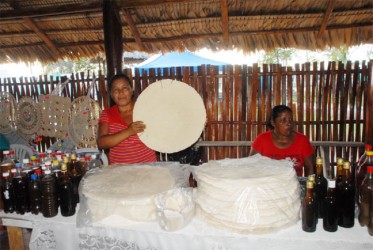For the past ten years a determined group of women have been journeying by boat, tractor and trailer, truck and Canter to Georgetown and to GuyExpo. These women are from Moraikobe and their mission is exposure for their products in a market that far exceeds any other to which they have access.
Moraikobe is the only Amerindian settlement in Region Five. It is situated in the upper Mahaicony River – 10 km or 6 miles up according

to the Gazetteer of Guyana. Moraikobe used to be called St Francis, but it now seems more comfortable with its indigenous name.
For the women of Moraikobe getting to GuyExpo is a costly, time-consuming and physically demanding journey. Truth be told, they arrive at Sophia with no more than a measure of hope that the returns would have made the journey worth the while.
Three years ago the women of Moraikobe created the Self-Skilled Association. Before that the women simply worked as a community, honing their traditional skills.
Chairman of the association Elizabeth Dick told Stabroek Business that the name of the group is intended to communicate the independence and self-reliant nature of its members.
At GuyExpo XV the women of the Self-Skilled Association were offering table mats, cassava bread, dolls, jewel boxes, baby slings and traditional Amerindian head gear. Most of the products were made from tibisiri. A few bottles of cassareep were also on display.
The women had agreed that at the end of GuyExpo 20 per cent of their modest takings would be ploughed back into the association. The chairman said that while that amount was insufficient to sustain a vibrant association, the high cost of transportation coupled with the fact that the exhibitors expected a modest income from the venture meant that 20 per cent was as high as they could go.
She said that at least seven members depend on the takings from GuyExpo to help maintain their children, some at the Mahaicony Secondary School and others at the Kuru Kuru Cooperative College on the Soesdyke-Linden Highway.
GuyExpo apart, the women of Moraikobe also market their products at Heritage Day events in Georgetown. Other modest marketing opportunities arise when visitors go to Moraikobe. There is also a modest market in Mahaicony, but overall it’s a threadbare existence.
Goods produced by the members of the association have limited markets. One of the association’s members, Dahanah said that GuyExpo and Heritage Day usually brought fair promises of better markets. None of those promises have materialised. Other groups, she said, have benefited from various forms of assistance including packaging, labelling and marketing. She said the group continues to hope that it will come to understand the procedures through which it can get help.
Dick was peeved over the “hassle” of moving goods between Moraikobe and Georgetown. It takes a full day to get from Moraikobe to Mahaicony. The first leg of the journey – by truck or tractor – lasts around two hours and gets the women and their goods as far as the Yarida Landing. A modest group with a fair amount of goods could pay as much as $10,000.
There are usually boats available at the Yarida Landing to ferry passengers on the second leg of the journey to Mahaicony. That trip could take around three hours. If, as is sometimes the case, the boat develops engine trouble, the trip could last almost a full day. These boats, however, only carry passengers and the cost per boatload is $50,000. A launch is used to ferry cargo and this usually takes an entire day. The cost could be as high as $15,000. These costs are shared among the owners of the goods being transported.
The final leg of the journey – from Mahaicony to Georgetown – requires a minibus, Canter or truck. The cost of the Canter is approximately $14,000.
This year, high costs meant that only six representatives from the association could make the journey to GuyExpo. They undertook to bring craft made by other members of the group to ensure that more people benefited from the event.
This year, the women of Moraikobe seemed more upbeat. Several potential buyers had evinced an interest in their craft and they were hoping that a few orders would come their way by the end of the event. At the very least they were hoping to recover costs.
Most of the men of Moraikobe work on timber grants. The women farm and produce cassava bread, cassareep and craft.
In recent times the community has been monitoring the enhanced prospects of the coconut industry as this might open some prospects. The women were keen to talk about possible markets. Transportation costs, however, were uppermost in their minds. In the meantime coconuts are harvested for the manufacture of coconut oil and copra.
There is also potential for pineapple production, but again the twin issues of production costs and markets arise. Most of the farmers have drifted away from pineapple farming.
The women hope the Mahaicony Market may provide a regular outlet for some of their goods. They hope too that the facility would be expanded and that in the not too distant future they might benefit from more reliable, less costly transport. Whatever happens between now and then, the women of Moraikobe plan to make the journey again for next year’s GuyExpo. They believe that in the fullness of time their fortunes will change.




